
We will recommend 10 most beautiful places for tourists to visit in Ethiopia.
Ethiopia is a land of stunning landscapes, rich history, and diverse cultures.
Here are the ten most beautiful places:
1. Lalibela, Ethiopia:
2. Simien Mountains National Park:
3. Lake Tana:
4. Gondar:
5. Omo Valley:
6. Axum:
7. Bahir Dar:
8. Harar Jugol:
9. Danakil Depression:
10. Debre Libanos:
1. Lalibela, Ethiopia, Ethiopia:
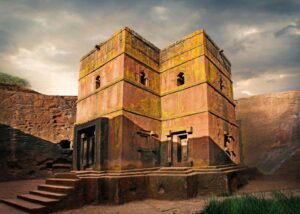
Lalibela is a historic town in Ethiopia, famous for its extraordinary rock-hewn churches and rich cultural heritage.
Often referred to as the “New Jerusalem,” it is a UNESCO World Heritage Site and a significant pilgrimage destination for Ethiopian Orthodox Christians.
The town is renowned for its 11 incredible churches, carved into solid rock during the 12th century under the reign of King Lalibela.
Each church boasts its own distinct architectural style, showcasing the deep religious roots and remarkable engineering skills of the time.
The most iconic of these churches, Bet Giyorgis, is designed in the shape of a cross and, therefore, stands as a remarkable example of medieval architecture.
Visitors can explore the intricately decorated interiors, which feature ancient paintings and religious artifacts. The atmosphere is serene, with prayers and services filling the air every day.
Lalibela attracts thousands of pilgrims each year, especially during Genna, the Ethiopian Orthodox celebration of Christmas when vibrant religious ceremonies take place.
In addition to its spiritual significance, the town is surrounded by breathtaking natural beauty, with rugged hills and lush landscapes. The nearby countryside offers excellent hiking opportunities and the chance to connect with the local community.
More than just a religious site, Lalibela is a lively cultural hub where visitors can experience Ethiopia’s unique traditions and the warm hospitality of its people.
In every way, Lalibela is an unforgettable destination, combining history, spirituality, and natural beauty to offer a truly remarkable experience.
2. Simien Mountains National Park, Ethiopia:
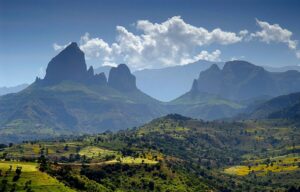
Simien Mountains National Park is one of the 10 most beautiful places for tourists, a breathtaking natural wonder located in northern Ethiopia, renowned for its dramatic landscapes, unique biodiversity, and rich cultural heritage.
Simien Mountains National Park, a UNESCO World Heritage Site, spans over 220 square kilometers and is home to some of Africa’s highest peaks, including Ras Dashen, which towers at 4,550 meters (14,928 feet).
The park’s rugged landscape, with its steep cliffs, deep valleys, and vast plateaus, makes it a paradise for hikers and nature enthusiasts.
Numerous trails provide stunning views of the mountains and opportunities to spot a variety of wildlife along the way.
Among the park’s unique inhabitants are the gelada baboon, found only in the Ethiopian highlands, and, in addition, the critically endangered Ethiopian wolf, which is one of the rarest canine species in the world.
The park is also home to special plants, such as the towering giant lobelias and colorful flowering herbs.
The changing seasons bring vibrant hues to the landscape, drawing photographers and outdoor lovers throughout the year.
In addition to its natural beauty, the park offers a glimpse into the rich culture of the surrounding villages, where visitors can experience the traditions and daily life of the Amhara people. You can also enjoy the warm hospitality and savor traditional Ethiopian cuisine.
Overall, Simien Mountains National Park is a perfect blend of adventure, breathtaking views, and cultural discovery.
Whether hiking through its stunning scenery or observing its rare wildlife, a visit to this remarkable park will leave you with unforgettable memories.
3. Lake Tana, Ethiopia:
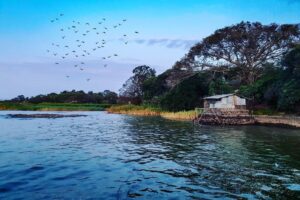
Lake Tana, the largest lake in Ethiopia, is located in the northwest part of the country and holds great significance both for its natural beauty and cultural heritage.
Spanning about 3,673 square kilometers, it’s known for its stunning landscapes, diverse wildlife, and historical importance.
One of the lake’s most fascinating features is its numerous islands, which are home to ancient monasteries and churches, some of which date back to the 14th century.
Key spots like Dek Island, with its monasteries of Ura Kidane Meheret and Kebran Gabriel, offer visitors a chance to admire beautiful frescoes and unique architecture.
These sites are especially significant to Ethiopian Orthodox Christians, who visit for both spiritual and historical reasons.
Lake Tana is also a haven for birdlife, including pelicans and many migratory species.
The lake is rich in fish, which is vital to the local communities, while the surrounding wetlands provide a habitat for a variety of plants and animals, helping to maintain a healthy ecosystem.
Another notable feature of Lake Tana is that it serves as the source of the Blue Nile River, which flows northward to merge with the White Nile in Sudan, making it crucial to the region’s water supply.
Visitors to Lake Tana can enjoy peaceful boat rides to explore its serene waters and, moreover, discover its picturesque islands.
With its natural charm, deep history, and vibrant local culture, Lake Tana is an essential stop for anyone visiting Ethiopia.
4. Gondar, Ethiopia:
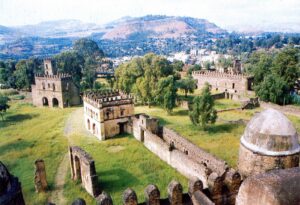
Gondar, often referred to as the “Camelot of Africa,” is one of the 10 most beautiful places for tourists, a historic city in northern Ethiopia renowned for its remarkable castles and rich cultural heritage.
Gondar, founded in the 17th century by Emperor Fasilides, served as the capital of Ethiopia for over 200 years.
Today, it’s a UNESCO World Heritage Site, showcasing the country’s unique architectural heritage.
The highlight of Gondar is the Royal Enclosure, a collection of castles and palaces, including the remarkable Fasil Ghebbi.
The site features stunning stonework and towers that blend Ethiopian and European architectural styles; as a result, it offers a glimpse into the royal life of Ethiopia’s kings and queens.
Gondar is also home to many beautiful churches, such as Debre Birhan Selassie, known for its exquisite murals depicting biblical scenes and saints.
The town has bustling markets and a variety of delicious local dishes, including injera and doro wat, providing visitors with an authentic taste of Ethiopian culture.
Nestled amidst lush green landscapes and the majestic Simien Mountains, Gondar is also a great destination for outdoor activities like hiking and enjoying the natural beauty of the area.
The city’s warm, welcoming people and rich traditions make it a perfect stop for travelers seeking both adventure and cultural immersion.
In every way, Gondar is a captivating blend of history, culture, and scenic beauty.
Whether exploring its ancient castles or savoring local delicacies, a visit to Gondar promises an unforgettable experience that showcases Ethiopia’s deep heritage.
5. Omo Valley, Ethiopia:
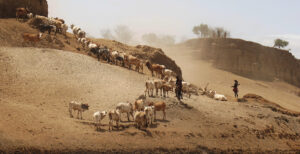
The Omo Valley is one of the 10 most beautiful places for tourists, a captivating region in southern Ethiopia, renowned for its stunning landscapes, diverse cultures, and rich traditions.
The Omo Valley is one of Africa’s most culturally diverse regions, home to numerous tribes, each with its own unique traditions, languages, and lifestyles.
The valley boasts dramatic landscapes, with the Omo River winding through lush hills and arid plains.
The river is a lifeline for local communities, providing essential water for farming and serving as a vital resource for wildlife.
Visitors to the Omo Valley can immerse themselves in the vibrant cultures of the tribes, such as the Mursi, known for their distinctive lip plates, and the Hamar, celebrated for their traditional bull-jumping ceremonies.
Engaging with these communities offers a rare opportunity to learn about their customs, artistry, and daily lives.
The region is also rich in wildlife, with nearby national parks like Mago and Omo National Parks, where you can spot elephants, giraffes, and a variety of bird species.
These parks are perfect for hiking, wildlife watching, and taking in the breathtaking natural beauty of the Ethiopian highlands.
For adventurous travelers, the Omo Valley offers a chance to explore a remote and culturally rich corner of Ethiopia; consequently, it provides a unique opportunity for discovery and adventure.
With its striking landscapes, diverse cultures, and authentic experiences, the Omo Valley is a must-visit destination for anyone seeking to understand the heart and soul of Ethiopia.
6. Axum, Ethiopia:
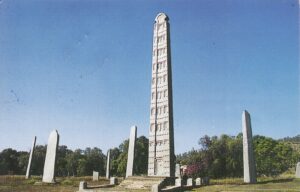
Axum is one of the 10 most beautiful places for tourists, an ancient city in northern Ethiopia, renowned for its rich history and archaeological significance.
Axum, once the capital of the Aksumite Empire, is one of the oldest continuously inhabited cities in the world. Moreover, it played a pivotal role in early Christian history and was a key center for trade in the region.
The city is best known for its towering obelisks and remarkable stone structures from the 4th century AD. Some of these obelisks rise over 20 meters and, furthermore, are intricately carved.
They were used as markers for royal tombs, symbolizing the power and wealth of the Aksumite rulers.
The largest of these obelisks, partially restored, showcases the impressive craftsmanship of ancient builders.
Axum is also home to the Church of St. Mary of Zion, a significant site for Ethiopian Orthodox Christians.
It is believed to house the Ark of the Covenant, making it an especially sacred place for many. The city hosts a variety of religious festivals throughout the year, drawing visitors from around the globe.
In addition to its historical and religious significance, Axum offers a glimpse into Ethiopia’s ancient trade routes, which once connected Africa, the Arabian Peninsula, and beyond.
The stunning landscapes, with rocky hills and fertile valleys, add to the area’s allure.
With its rich history, deep spirituality, and vibrant culture, Axum is, without a doubt, a must-visit destination for anyone interested in Ethiopia’s heritage.
The blend of ancient wonders and lively traditions makes a lasting impression on all who visit.
7. Bahir Dar, Ethiopia:
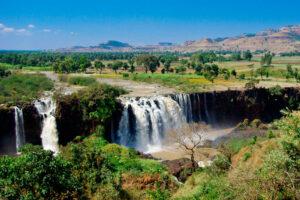
Bahir Dar is one of the 10 most beautiful places for tourists, a picturesque city located on the shores of Lake Tana in northern Ethiopia, known for its stunning landscapes, rich history, and vibrant culture.
Bahir Dar, the capital of the Amhara Region, is an ideal starting point for exploring some of Ethiopia’s most significant natural and historical attractions.
One of the main highlights of Bahir Dar is Lake Tana, Ethiopia’s largest lake. In addition, the lake is home to over 20 islands, many of which feature ancient monasteries and churches.
A well-known site is Ura Kidane Meheret, celebrated for its stunning paintings and historical significance.
Visitors can take boat trips across the serene waters of the lake, where they can observe local fishing communities going about their daily routines.
Bahir Dar is also conveniently located near the Blue Nile Falls, or Tis Issat, meaning water that smokes. These dramatic falls are particularly breathtaking during the rainy season, as the water plunges into the river below.
The city is known for its charming palm-lined streets, vibrant markets, and delicious local cuisine, including traditional dishes like injera and doro wat.
Visitors can immerse themselves in the local culture by interacting with artisans and enjoying the bustling atmosphere.
Bahir Dar also serves as a great base for exploring Simien Mountains National Park, a UNESCO World Heritage Site renowned for its stunning landscapes and unique wildlife.
With its blend of natural beauty, rich history, and warm hospitality, Bahir Dar is a must-visit destination for anyone traveling to Ethiopia.
Its combination of adventure, culture, and scenic charm guarantees an unforgettable experience.
8. Harar Jugol, Ethiopia:

Harar Jugol, the ancient walled city of Harar in eastern Ethiopia, is a UNESCO World Heritage Site and holds the distinction of being the fourth holiest city in Islam.
Known for its vibrant culture, fascinating history, and distinctive architecture, Harar offers visitors a unique experience.
Founded in the 7th century, Harar has long been an important hub for trade, culture, and religion. The city is encircled by a sturdy wall built in the 16th century to protect it from invaders, adding to its historical significance.
Inside the walls, the narrow streets are lined with traditional homes, which, in addition, feature intricate wooden balconies and colorful facades.
Harar boasts over 80 mosques, some of which are centuries old, showcasing stunning examples of Islamic architecture.
One of the city’s most captivating sights is the hyena man, a local tradition where people feed wild hyenas in the evening.
This rare and intriguing practice draws many visitors eager to witness the remarkable bond between humans and wildlife.
The bustling Harar Grand Market is a sensory delight, offering everything from spices and textiles to handmade crafts.
Harar is also renowned for its coffee, a key element of Ethiopian culture, and visitors can enjoy traditional coffee ceremonies in the city’s cozy cafes.
Culturally, Harar is rich in poetry and music, reflecting its diverse heritage. The city is home to a variety of ethnic groups, and its people are known for their warmth and hospitality.
In all, Harar Jugol presents a unique blend of history, culture, and nature, making it an unforgettable destination for anyone visiting Ethiopia.
9. Danakil Depression, Ethiopia:
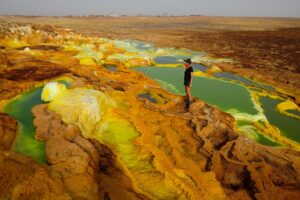
The Danakil Depression, located in northeastern Ethiopia, is one of the most extreme and unique places on Earth.
Known for its otherworldly beauty, it is also one of the hottest places on the planet, with temperatures regularly surpassing 50 degrees Celsius (122 degrees Fahrenheit).
This remarkable region was shaped by tectonic activity and volcanic eruptions, resulting in a landscape full of salt flats, colorful mineral deposits, and active volcanoes.
One of the most striking sights is the Dallol crater, where sulfur springs and acidic pools display vibrant colors of yellow, orange, and green, creating a scene that feels like something from another world.
The area is also home to Erta Ale, one of the few continuously active lava lakes, drawing adventurers and scientists alike to witness its constant fiery spectacle.
The Afar people have lived in the Danakil Depression for centuries, adapting to the harsh environment while preserving their distinct culture.
Visitors to this extreme landscape can interact with local communities and learn about their traditional ways of life.
Despite its challenging conditions, the Danakil Depression offers incredible opportunities for adventure and exploration.
With its surreal terrain, fascinating geological features, and rich cultural heritage, the Danakil Depression is a must-see destination for anyone seeking an unforgettable journey.
It stands as a powerful reminder of the Earth’s geological forces, offering a rare glimpse into a landscape shaped by extreme conditions and vibrant local culture.
10. Debre Libanos, Ethiopia:

Debre Libanos is one of the 10 most beautiful places for tourists, a historic and picturesque monastery located about 110 kilometers north of Addis Ababa, Ethiopia.
Debre Libanos was founded in the 13th century by Saint Abbo and has since become one of the most significant religious sites in Ethiopian Orthodox Christianity.
Nestled in the stunning Ethiopian highlands, the monastery offers breathtaking views of the surrounding valleys and the Blue Nile Gorge.
The monastery is home to beautiful churches adorned with intricate paintings and ancient manuscripts, reflecting the rich artistic and spiritual history of the region.
The most famous building is the Church of Saint Abbo, which draws many pilgrims, particularly during major religious festivals.
Debre Libanos also holds historical importance for its role in helping Ethiopia resist foreign invasions.
For centuries, it has been a center of learning and spiritual guidance, playing a key part in preserving Ethiopian culture and Christianity.
Visitors to Debre Libanos can stroll along peaceful walking paths through lush landscapes, perfect for birdwatching and connecting with nature.
Just nearby, the Portuguese Bridge, built in the 17th century, offers a picturesque spot for photos and serves as an important historical landmark.
The warm, welcoming local community further enriches the experience, offering visitors a chance to engage with traditional Ethiopian culture.
Overall, Debre Libanos combines spirituality, history, and natural beauty, making it a must-visit destination for anyone looking to explore Ethiopia’s rich religious and cultural heritage.
Its serene atmosphere leaves a lasting impression on all who visit.
These remarkable destinations highlight Ethiopia’s incredible natural beauty, deep history, and cultural diversity, making it an endlessly fascinating country to explore.




